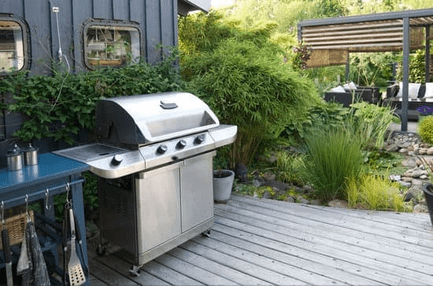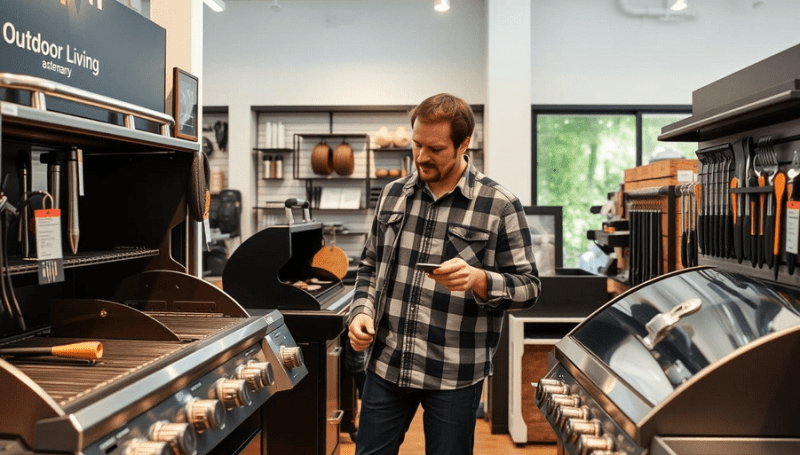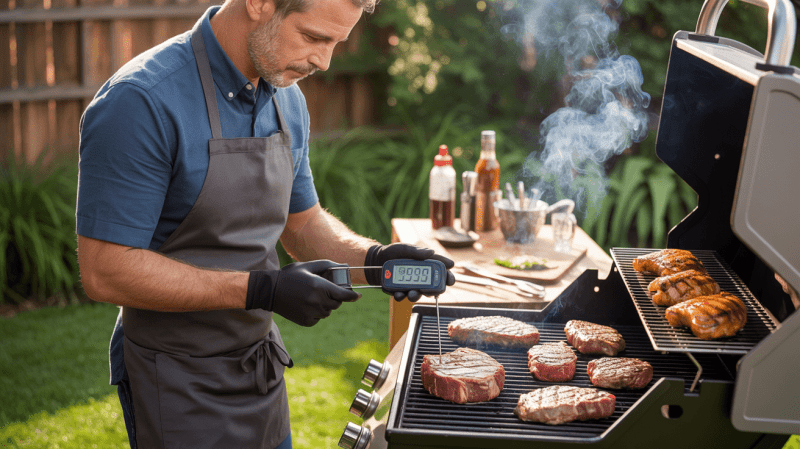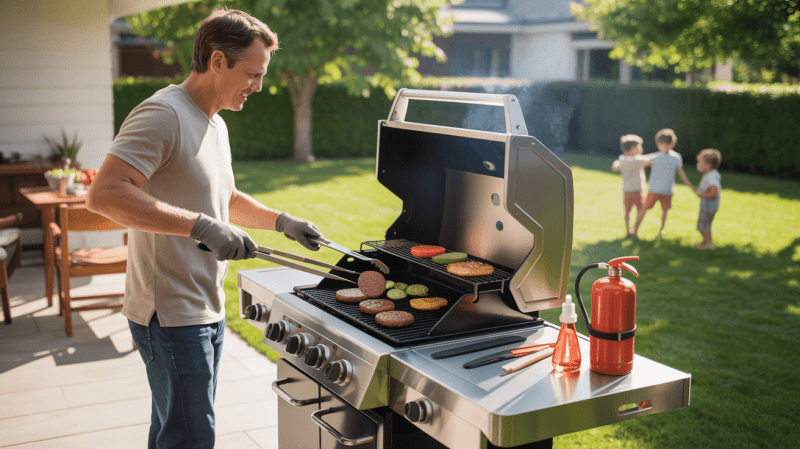Grill size FAQs: getting it right the first time:
Picking the wrong grill size can get expensive fast. People often assume bigger is always better or grab the cheapest small model without stopping to think about their real needs.
The most common grill sizing mistakes include buying a grill that's too large for the space, too small for the cooking needs, or ignoring how the cooking surface layout affects meal preparation.

Get the size wrong, and you’re either cramming food onto a tiny grill or wrestling with a monster that hogs space and wastes fuel. A grill that's too big can heat unevenly, so some food burns while other parts barely cook.
These problems turn what should be a fun backyard cookout into a hassle.
Key Takeaways
- Buying a grill that's too big or too small for your actual cooking needs leads to wasted money and poor cooking results.
- Ignoring your available space and placement requirements can create safety issues and limit grill functionality.
- Failing to consider maintenance requirements and grill features often results in long-term dissatisfaction with the purchase
Overestimating or Underestimating Grill Size Needs

Many grill buyers select the wrong size for their actual needs. Some go too small and struggle to keep up with their cooking demands, while others buy oversized grills that consume space and money.
Buying a Grill That Is Too Small
A grill that's too small makes life tough for the cook. You can’t prep enough food at once for family or guests.
Most standard grills offer 400 to 550 square inches of cooking space. That accommodates four to five people, at most.
Bigger families need larger grills to cook meals efficiently. Small grills force you to cook in batches, which takes forever.
Hot food gets cold while you wait for the next batch. It’s just not ideal.
Common signs a grill is too small:
- Food doesn't fit on the cooking surface
- Multiple cooking sessions needed for one meal
- Long wait times between batches
- Guests are eating at different times
Cooks also struggle with cooking zones. Small grills just don’t have space for both direct and indirect cooking. That makes it tough to prepare foods that need different heat levels.
Choosing a Grill That Is Larger Than Necessary
Going too big brings a different set of headaches. Large grills cost more upfront and consume more fuel every time you use them.
Big grills hog patio or deck space. They’re also a pain to store in winter.
Oversized grills waste fuel on small meals. Gas grills burn through propane, and charcoal grills need extra charcoal to heat the whole thing.
Problems with oversized grills:
- Higher purchase price
- Increased fuel consumption
- Takes up too much space
- Harder to maintain temperature control
- More cleaning required
Large cooking surfaces make it tricky to keep the heat even. When you’re just grilling a couple of burgers, it’s overkill and a hassle.
Not Considering Regular Versus Occasional Cooking Needs
People often buy grills for that one big party instead of what they actually cook most weeks. They picture the biggest BBQ they’ll ever throw, not the regular Tuesday night dinner.
If you grill twice a week for four people, you don’t need the same setup as someone who hosts monthly blowouts. Regular habits should steer your choice, not rare events.
Questions to consider:
- How many people do you cook for weekly?
- How often do you host large groups?
- What types of food do you grill most?
- Do you cook multiple items at once?
It makes sense to pick a grill that handles 80% of your meals well. You can always batch-cook or borrow gear for the occasional big bash.
Think about the future, too. If your family might grow or you’ll entertain more, leave yourself some wiggle room.
Ignoring Cooking Surface Area and Layout

Many people focus on the grill’s overall size and overlook the actual cooking space. The layout matters more than the outside measurements.
Confusing Cooking Surface With Number of Burners
Some folks see more burners and assume that means more room to cook. Not always true.
A three-burner grill can have less usable space than a smartly designed two-burner. Burner placement and grate design really decide how much you can cook at once.
Key factors that affect the cooking surface:
- Grate spacing between burners
- Distance from burners to cooking surface
- Shape and size of individual grates
Gas grills with cramped burners create hot spots and cold zones. That makes even cooking a pain.
Measure the total square inches of the main cooking surface. Don’t get distracted by burner count.
For most families, 350 to 500 square inches on the main grates is the sweet spot.
Not Factoring in Top Shelves and Warming Racks
People often overlook upper cooking areas when selecting a grill size. Top shelves and warming racks add space, but they’re not a replacement for a good main grate.
These spots are great for keeping food warm or for items that need less heat. Think veggies, buns, or delicate stuff.
Common upper cooking features:
- Warming racks above the main grates
- Secondary cooking shelves
- Rotisserie attachments
Some grill makers count these upper areas in the total cooking space, which can be misleading. Always check how much main grate space you’re actually getting.
Upper racks are a bonus, not the main event. The main grates should handle most of your cooking.
Overlooking Space and Placement Considerations
It’s easy to make sizing mistakes if you don’t measure your outdoor area or consider where the grill will be located. Placement issues can turn your dream setup into a cramped, awkward mess.
Neglecting Available Outdoor Space
Homeowners sometimes buy grills that don’t fit their patios or decks. Cooking capacity sounds great until you realize you can’t even open the lid all the way.
Essential clearance requirements include:
- 3 feet minimum on all sides for safety
- 10 feet from house walls or overhangs
- 5 feet from property lines or fences
- Extra space for opening grill lids and doors
Small patios work best with grills under 400 square inches. Medium decks can handle up to 600. Got a huge yard? Go wild with 800+ square inches if you want.
Don’t forget about furniture. You need room for prep tables, chairs, and guests to move around. Crammed spaces make cooking tough and less safe.
Wind matters, too. You want smoke blowing away from people and neighbors. Corners often provide better airflow than placing the grill directly in the center.
Forgetting About Portability and Storage
Big, heavy grills are tough to move and store. If you need to drag your BBQ in for the winter or move it to clean, weight becomes a real issue.
Weight considerations by grill type:
- Portable grills: 20-50 pounds
- Cart grills: 100-200 pounds
- Built-in grills: 300+ pounds (permanent)
If you’re in an apartment, you’ll want a lightweight, compact model you can stash inside. Homeowners with garages can go heavier, especially if the grill has wheels.
Weather protection is huge for grill life. If your grill doesn’t have a cover, you’ll need storage space for winter. Built-ins need permanent shelter.
Measure doorways, stairs, and tight spots before buying a big grill. You don’t want to find out it won’t fit after you get it home.
Disregarding Primary Grill Type and Features
People get caught up in size and forget about the grill type and features. That’s a fast track to disappointment.
Selecting the Wrong Type: Gas, Charcoal, or Electric
Gas grills are the go-to for convenience. They heat up fast and let you dial in the temperature with a twist.
Gas grills work best for:
- Quick weeknight dinners
- Large family gatherings
- People who want consistent results
- Cooks who prefer easy cleanup
Charcoal grills bring the flavor, but they take more time and effort. You’ll wait 15-20 minutes just to get them ready.
Electric grills are a good option for apartments or areas with fire bans. They heat evenly but don’t get hot enough for a proper sear.
Consider your cooking frequency. If you grill daily, gas is just easier. If you only fire up the grill on weekends and love smoky flavor, charcoal might be your jam.
The best gas grill for you really depends on how often you cook outside. Gas costs more at first but saves you time and hassle in the long run.
Overlooking Essential Features for Your Cooking Style
Temperature control usually matters more than grill size if you want consistent results. Multiple burners allow you to set up different heat zones for various types of food.
Essential features include:
- Adjustable burners - You can fine-tune the heat for different cooking styles.
- Built-in thermometer - Keep an eye on the internal temperature without guessing.
- Ignition system - A push-button or electronic start saves hassle when lighting up.
- Grease management - Removable drip trays and channels make cleanup less annoying.
Side burners give you extra space for sauces or sides if you like multitasking. Rotisserie attachments are ideal for cooking whole chickens or large roasts.
Storage space keeps your tools and supplies organized and accessible. Enclosed cabinets and side shelves are worth considering when shopping for a grill.
Match features to your cooking style. If you love searing, go for high BTU ratings and maybe an infrared burner. For low-and-slow cooks, precise temperature controls and a smoking box will make your life easier.
Underappreciating Maintenance and Longevity
Many buyers focus on cooking space and overlook how size affects cleaning and maintenance. Larger grills typically require more specialized cleaning tools, and replacement parts can be difficult to find.
Choosing Models That Are Hard to Clean
Big, complicated grills bring cleaning headaches that catch people off guard. Multi-level surfaces, deep fireboxes, and wide grates mean you’ll spend more time scrubbing.
Grill brush access gets tricky with oversized models. Standard brushes just can’t reach every corner. You’ll probably want longer handles or special tools to get the job done.
Grease management systems aren’t all created equal. Bigger grills make more grease and some models put the trays in frustrating spots.
Key cleaning challenges by size:
- Small grills: Not much room to maneuver cleaning tools
- Medium grills: You get a nice balance of access and cleaning time
- Large grills: Separate cooking zones mean more spots to clean
- Extra-large grills: Expect to need special brushes and longer cleaning sessions
Complex grills with lots of burners add even more surfaces to care for. Each burner needs attention. Heat deflectors and flavorizer bars add to your to-do list.
Ignoring Ease of Grill Care and Replacement Parts
Replacement parts for large grills often cost more and can be hard to track down. Manufacturers usually stop making parts for oversized specialty models before standard ones. Standard-sized grills just have better parts availability, plain and simple.
Large grill grates can get expensive to swap out. One section for a large grill might run $50-100, and if you need several, the cost adds up quickly.
Common replacement needs:
- Cooking grates (every 2-3 years)
- Heat deflectors (every 3-4 years)
- Burner tubes (every 5-7 years)
- Grease management parts (annually)
Bigger grills require more supplies for maintenance each season. Covers get pricier as the grill size goes up. You’ll also burn through more cleaning products and protective sprays.
Storage space plays a huge role in how long your grill lasts. People often pick a big grill without thinking about where to keep it. Bad storage means faster wear and more parts to replace down the road.
Frequently Asked Questions
People ask all sorts of things about grill sizing that go way beyond just measuring. Most questions focus on cooking capacity, fitting the grill into your space, and how your favorite foods affect what size you need.
What factors should I consider to determine the appropriate grill size for my cooking needs?
The cooking surface area is the big one. Small grills usually give you 300-400 square inches. Medium options have 400-600, and the big boys go over 600 square inches.
Measure your outdoor area before you buy. Leave at least 3 feet of clearance on every side—nobody wants to mess with fire codes or safety issues.
Budget matters too. Larger grills cost more up front and use more gas or charcoal each time. That adds up over the summer.
Consider storage if you plan to move the grill for the winter. Check your garage or shed first. Some grills are not designed to be moved around.
How does the number of people I regularly cook for affect the size of the grill I should choose?
Figure on about 72 square inches per person for main dishes. For a family of four, you’ll want at least 288 square inches. That way, everyone eats at the same time.
Small grills work for 1-3 people. Medium handles 4-6. Large grills are for seven or more—no waiting around for the next batch.
Don’t just think about daily meals if you host big gatherings a couple of times a year, size up. Cooking in batches for a crowd isn’t much fun.
If you grill lots of sides or veggies, add another 20-30% to your cooking area. You’ll thank yourself later.
Are there any negative consequences of choosing a grill that is too large for my space?
Oversized grills can be a safety nightmare in tight spots. Too close to walls or furniture, and you’re asking for trouble. Fire risk goes up, and you might break some codes.
Large grills waste fuel when you’re cooking for just one or two. Gas and charcoal costs sneak up over time. Plus, they take longer to heat up.
Storing a huge grill gets tricky. Some won’t fit through doors or in sheds. Moving them can turn into a two-person job.
Cleaning? Yeah, it takes a lot longer. More surface area means more scrubbing after every cookout.
How do the types of food I plan to grill influence the grill size I need?
Whole chickens or big roasts need extra space. Indirect cooking means you need room to pull food away from the heat. Plan for separate temperature zones.
Small foods like shrimp or veggies cook fast but need space to spread out. Crowded grates make for uneven results. Fish fillets, especially, need room to flip without falling apart.
Burgers and hot dogs are easy—they pack tightly and cook at the same temperature. You can fit a bunch on a small grill.
If you want to cook multiple things at once, set up separate zones. Keep raw and cooked stuff apart. Different proteins usually need different temperatures too.
Can the grill size impact the overall cooking time and temperature control?
Bigger grills take longer to preheat. You may need to wait an extra 10-15 minutes to reach your target temperature.
On the plus side, large grills often have better heat distribution. More burners or charcoal space means you can set up proper temperature zones. That’s great for indirect cooking.
Wind can mess with big grills more than you’d expect. Large lids catch the breeze and lose heat faster. Cooking times get unpredictable outdoors.
Small grills heat up fast, but they can have hot spots. Food near the edges cooks differently, so you’ll be moving things around more often.
What are the common oversights when calculating the space needed for a grill in an outdoor area?
People often forget to measure with the lid open. Grills need extra clearance above when you lift the lid.
Check for overhead branches or low patio coverings. Sometimes, folks just eyeball it and end up with a grill that bumps into things.
Side tables and prep areas take up more room than you'd think. Many grills have fold-down shelves that stick out and expand the footprint.
Give yourself enough space, actually, to work around the grill. It's not fun squeezing in with hot food or sharp tools.
Propane tanks need their own spot. You have to store them somewhere ventilated and away from heat, which isn't always obvious at first.
Some places even have rules about where you can put the tank. It's worth double-checking so you don't have to move everything later.
Grease management systems also need some thought. Drip pans and grease cups should be easy to reach for cleaning.
Leave a little room around the back and sides. You'll thank yourself when it's time to clean up or do a quick fix.
DISCLAIMER
This document is provided for general information purposes only and should not be relied upon as providing legal advice, technical, or specific operational guidance to the reader, whether as to the practices described in the document or the applicable legal requirements and regulations. outdoorgrillguide.com expressly disclaims any responsibility for liability arising from or related to the use or misuse of any information in this document.



